As an Amazon Associate KitchenwareSets.com earns from qualifying purchases.
European Cottage Kitchen Ideas For Cozy Charm On Any Budget
Have you found yourself scrolling through Pinterest, completely captivated by images of sun-drenched European cottage kitchens? There’s an undeniable magic to them—a blend of rustic charm, effortless elegance, and a deep, lived-in comfort that feels like a warm hug. They promise a slower pace of life, filled with the aroma of fresh bread and the simple joy of a shared meal.
But then, reality sets in. You look at your own kitchen, and the dream feels distant. The words “renovation,” “custom cabinetry,” and “reclaimed materials” often come with hefty price tags and overwhelming project plans. It’s easy to believe that achieving that authentic, collected-over-time charm requires a massive budget and a trip to a French flea market, leaving you feeling like it’s an unattainable fantasy.
Here’s the secret: A European cottage kitchen blends rustic charm with a warm, lived-in feel, emphasizing natural materials like wood and stone, soft, muted colors, and vintage elements. It’s a style focused on creating a cozy, authentic, and inviting atmosphere, and the best part is, this charm is absolutely achievable on any budget through smart, strategic choices. This guide is your roadmap, filled with actionable steps and inspiring ideas to help you create the cozy kitchen of your dreams, one thoughtful detail at a time.
Dreaming of a Cozy European Kitchen But Worried About the Cost?
A European cottage kitchen achieves its cozy charm by blending rustic, natural materials with a warm, inviting, and lived-in feel, often emphasizing vintage elements and a comfortable aesthetic. This style prioritizes authenticity and can be created on various budgets through strategic design choices and staged renovations.
I remember standing in my own builder-grade kitchen, dreaming of something more. I wanted character, warmth, and a space that told a story. The sleek, modern finishes felt cold and impersonal. Like you, I scrolled endlessly through images of kitchens with aged brass fixtures, soft, chalky paint, and open shelves displaying mismatched pottery.
The thought of a full-scale renovation was daunting, both financially and logistically. But I learned through experience that the soul of a European cottage kitchen isn’t found in a hefty price tag; it’s curated through layers of texture, personal touches, and intentional choices. It’s a journey, not a destination, and it can start today, right where you are. This post is born from that journey, designed to show you how to transform your kitchen into a character-filled retreat with practical, budget-friendly strategies.
What is the Difference Between European Cottage and Farmhouse Style?
While both styles are rustic, a European cottage kitchen leans more romantic and whimsical, featuring softer colors and an eclectic mix of collected vintage finds. In contrast, the classic American farmhouse style is often more utilitarian and practical, characterized by cleaner lines and a more neutral, structured aesthetic.
Disentangling these two popular styles can be tricky because they share a love for natural materials and a cozy feel. However, their core philosophies differ. Think of it as a difference in personality. I’ve spent countless hours studying design nuances, and the distinction really comes down to the feeling each space evokes.
Here’s a breakdown to help you find the style that truly speaks to you:
- Overall Vibe:
- European Cottage: Whimsical, romantic, quaint, and collected. It feels like a storybook setting, intimate and personal.
- Farmhouse: Grounded, practical, clean, and family-oriented. It’s rooted in function and durability, with a nod to rustic simplicity.
- Color Palette:
- European Cottage: Dominated by soft, muted colors. Think creamy whites, dusty pastels (pinks, blues, greens, yellows), and earthy tones that create a light, airy feel.
- Farmhouse: Often relies on a higher-contrast, neutral palette of crisp whites, blacks, and grays, accented with natural wood.
- Decor & Accessories:
- European Cottage: Celebrates imperfection and history. You’ll see mismatched vintage pottery, delicate floral prints, aged brass, and foraged floral arrangements.
- Farmhouse: Leans towards functional decor. Think wire baskets, enamelware, shiplap walls, and practical items like large cutting boards and galvanized metal.
9 Timeless European Cottage Kitchen Ideas For 2025
To create a timeless European cottage kitchen, focus on nine foundational elements: soft color palettes, warm wood tones, open shelving, vintage accents, charming hardware, ambient lighting, a farmhouse sink, cozy textiles, and architectural details. These core components work together to build an atmosphere of rustic elegance and comfort.
Ready to bring this charming style to life? The good news is you don’t have to tackle everything at once. In my experience, the most authentic cottage kitchens evolve over time. This list is your blueprint. It covers everything from simple, budget-friendly swaps to more involved updates, allowing you to choose a starting point that feels right for you and your home. Let’s dive into the essential ingredients for creating that coveted cozy charm.
1. Embrace Soft, Muted Color Palettes
The foundational step to a cottage kitchen is choosing a soft, muted color palette to create a light, airy, and inviting atmosphere. Shades of white, cream, pastels, and earth tones are essential for enhancing the cozy and romantic nature of the space.
Color is the single most transformative tool in your design arsenal, and in a cottage kitchen, it sets the entire mood. Forget stark, clinical whites. We’re aiming for colors that feel like they have a story to tell—hues softened by time and sunlight. Think of the color of fresh cream, the pale green of new spring leaves, or the buttery yellow of a wildflower. These colors reflect light beautifully, making even a small kitchen feel more spacious and serene.
Materials Needed:
* Paint swatches (in whites, creams, soft blues, sage greens, buttery yellows)
* Painter’s tape
* Paint brushes/rollers
* Drop cloths
* Primer (if needed)
Step-by-Step Directions:
1. Gather paint swatches in your target color family. Don’t be shy—bring home a dozen options. Tape several to your cabinet doors and walls.
2. Observe the colors over a full 24-48 hours. Notice how they shift and change in the morning light versus the warm glow of evening lamps. This is a crucial step I learned the hard way!
3. Select a primary color for your cabinets or walls. Choose a complementary white or cream for the trim to create a gentle, low-contrast look that feels cohesive.
4. Properly prep your surfaces. Clean them thoroughly with a good degreaser and give them a light sanding to help the paint adhere. Apply a quality primer, especially if you’re making a drastic color change.
5. Apply 2-3 thin coats of your chosen paint, allowing for adequate drying time between each coat for a durable, beautiful finish.
Pro-Tip: Don’t just look at a small paint chip. Buy sample pots and paint a large poster board for each of your top three colors. Move the boards around the room throughout the day to see how the light truly affects the shade in your specific space. This little trick has saved me from countless painting regrets.
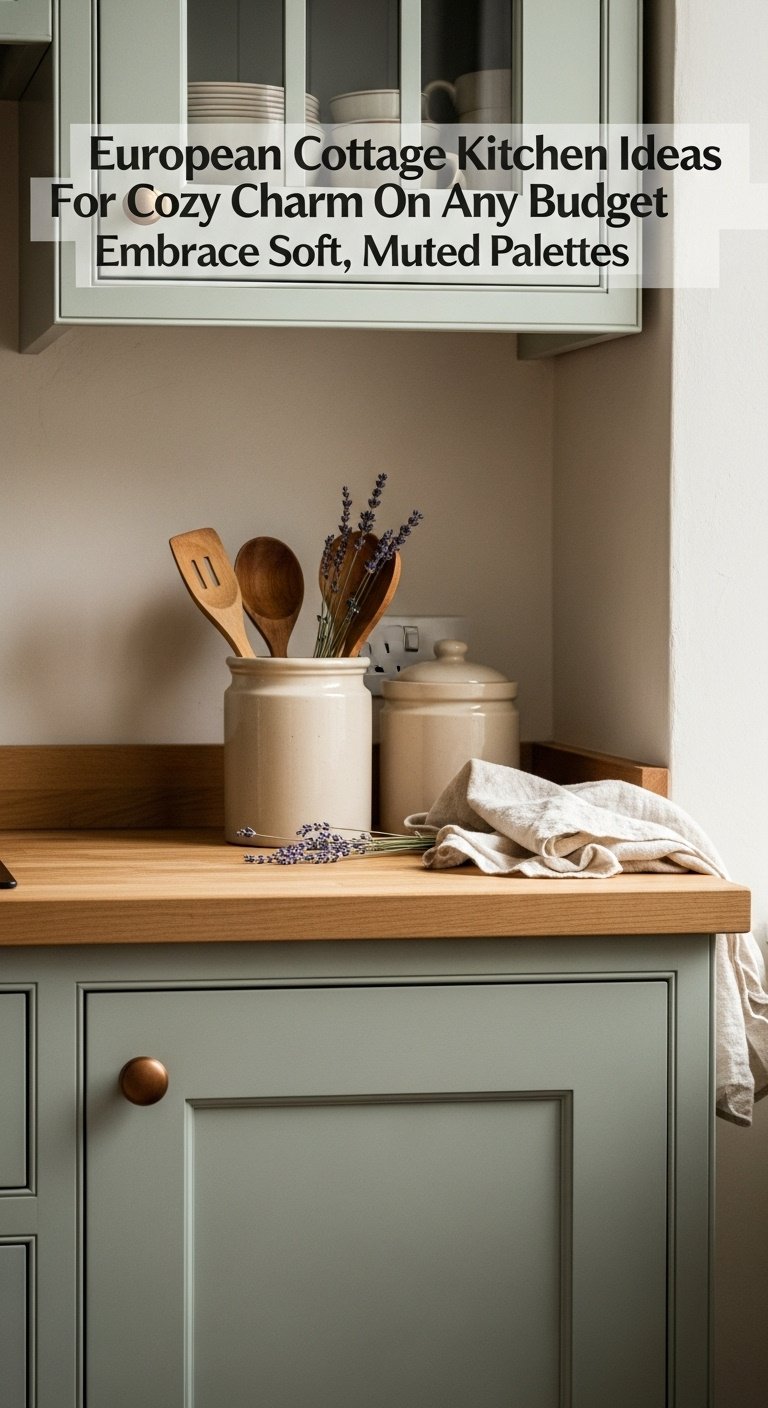
Save this color inspiration to your “Dream Kitchen” Pinterest board!
2. Weave in Warm Wood Tones
To achieve an authentic cottage feel, you must incorporate warm wood tones and reclaimed wood to bring a touch of nature indoors. Elements like butcher block countertops, wooden shelves, and ceiling accents instantly add character, warmth, and a sense of history.
Wood is the heart of a rustic kitchen. It’s a living material that tells a story through its grain, knots, and imperfections. It prevents the soft color palette from feeling cold and adds a layer of organic texture that is essential to the cottage aesthetic. From the smooth, practical surface of a countertop to the rugged charm of an old beam, wood connects the kitchen to the natural world.
Materials Needed:
* Butcher block conditioner/oil
* Soft cloths
* Fine-grit sandpaper (220-grit)
* Wooden cutting boards
* Wooden utensil crock
* Floating shelf brackets
* Reclaimed wood plank
Step-by-Step Directions:
1. Start Small: This is the easiest entry point. Introduce wood through beautiful, functional accessories. Display a collection of vintage wooden cutting boards against your backsplash or gather your favorite wooden spoons in a heavy ceramic crock.
2. Condition Existing Wood: If you already have butcher block countertops, bring them back to life. Sand them lightly with fine-grit sandpaper and apply a food-safe conditioner or mineral oil. The richness of the color that emerges is incredibly rewarding.
3. Install a Focal Shelf: Source a piece of reclaimed wood from a local lumberyard or architectural salvage shop. Sand it just enough to remove splinters but preserve its aged character. Install it on a prominent wall using sturdy, decorative brackets for a statement open shelf.
Lesson Learned: Not all wood tones need to match perfectly. In my own kitchen, I discovered that mixing different types and finishes of wood—like a light pine shelf with a deeper oak countertop—actually enhances the authentic, collected-over-time feel of a true cottage kitchen. It’s the opposite of a sterile, uniform showroom.
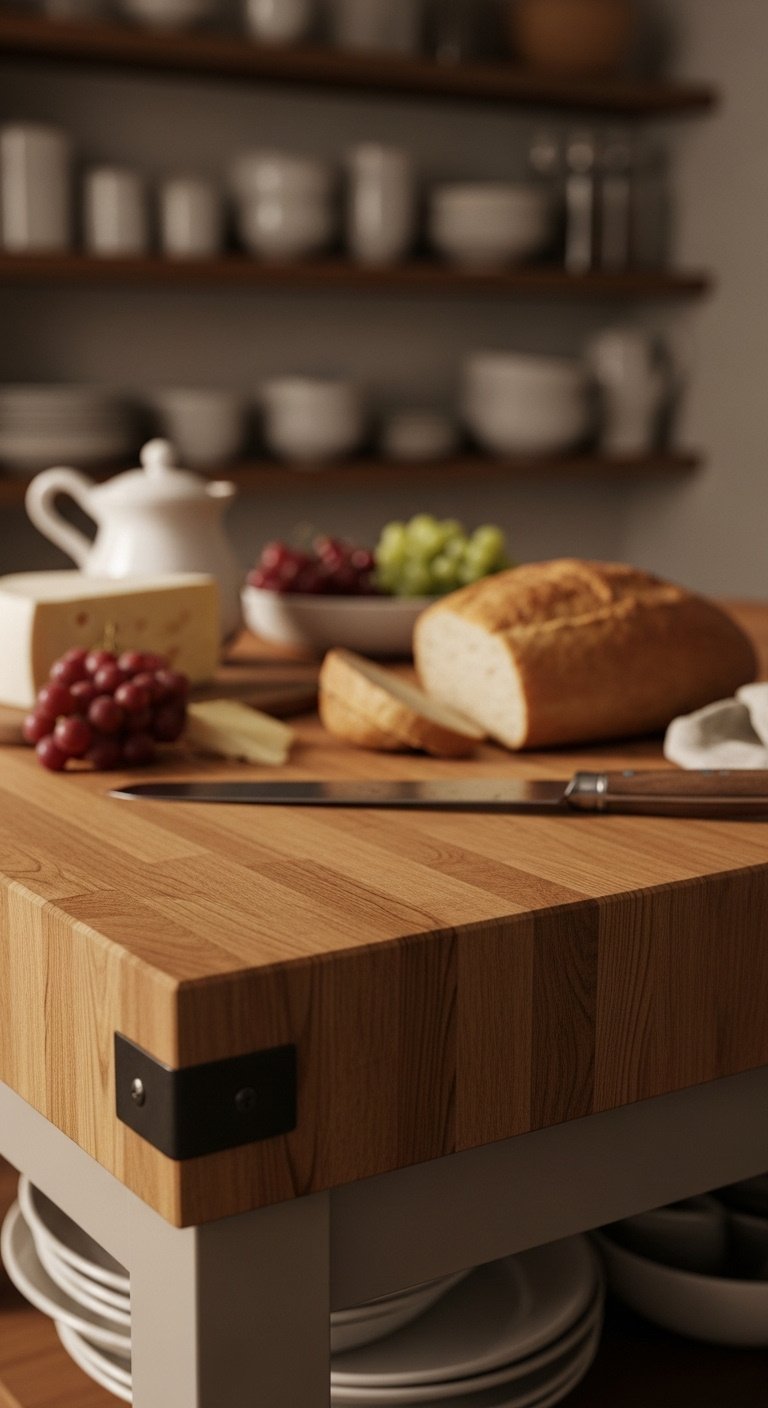
Love this rustic look? Pin it for your future kitchen island!
3. Create an Airy Feel with Open Shelving
A hallmark of the cottage style is using open shelving to display collected dishware and decor, which makes a kitchen feel more personal and airy. If full open shelving isn’t practical, a budget-friendly alternative is to simply remove the doors from existing upper cabinets.
Heavy upper cabinets can make a kitchen feel top-heavy and closed-in. Open shelving, on the other hand, creates visual breathing room. It invites you to curate your everyday items—your favorite mugs, stacks of plates, and vintage finds—and turn them into a beautiful, functional display. It’s a style that celebrates the beauty in the everyday.
Materials Needed:
* Screwdriver/drill
* Wood filler
* Sandpaper
* Touch-up paint
* Stud finder
* Level
* Shelf brackets
* Wood planks
Step-by-Step Directions (Budget Method):
1. Start by emptying one or two of your upper cabinets. Carefully unscrew the hinges from the cabinet frame to remove the doors.
2. Fill the old hinge holes with a small amount of wood filler. Let it dry completely according to the package directions.
3. Once dry, sand the filled holes until they are perfectly smooth and flush with the cabinet frame.
4. Use a small brush and touch-up paint (or the original cabinet paint) to cover the sanded spots. For a truly finished look, give the entire interior of the cabinet a fresh coat of paint.
5. Now for the fun part: Style your new “open cabinet” with your prettiest dishes, glassware, and a few decorative objects.
Pro-Tip: For true cottage charm, resist the urge to display a perfectly matching set of white dishes. The magic is in the mix! In my experience, combining vintage floral plates from a thrift store, small potted herbs, and stacks of soft linen napkins creates a vignette that is not only beautiful but also deeply personal and functional.
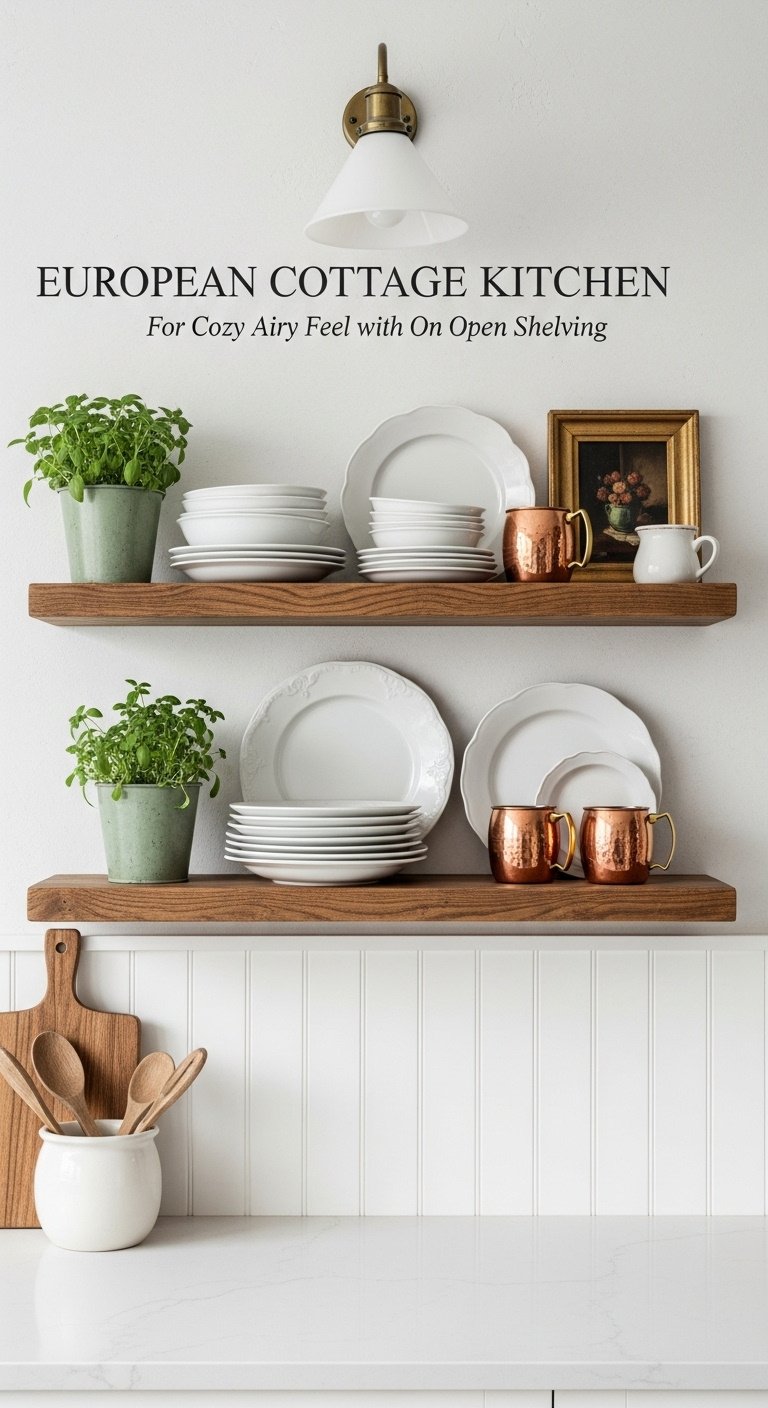
Tap to save this shelf styling inspiration!
4. Incorporate Vintage and Handmade Elements
To infuse your kitchen with a timeless appeal, you must embrace the unique and imperfect beauty of vintage and handmade elements. Items from flea markets, antique kitchenware, handmade tiles, and repurposed furniture add layers of character and history that new items simply cannot replicate.
This is where the soul of your cottage kitchen truly develops. It’s in the crazing on an old ceramic pitcher, the worn patina of a copper pot, or the story behind a painting you found at a flea market. These items connect your modern life to the past and ensure your kitchen is a one-of-a-kind reflection of you, not a page from a catalog.
Materials Needed:
* An antique dresser or small table
* Sandpaper (medium and fine grit)
* Chalk paint
* Wax or polycrylic sealer
* New hardware (optional)
* Soft cloths
Step-by-Step Directions (DIY Mini-Island):
1. Go on a treasure hunt! Find a sturdy, counter-height vintage dresser or small table at a local flea market, thrift store, or on Facebook Marketplace.
2. Clean the piece thoroughly to remove any dirt and grime. Then, lightly sand the entire surface to scuff it up and help the paint adhere.
3. Apply 1-2 coats of chalk paint in a cottage-friendly color like a creamy white, dusty blue, or soft gray. Chalk paint is very forgiving and often requires no primer.
4. Once the paint is fully dry, use a piece of fine-grit sandpaper to lightly distress the edges and corners where natural wear and tear would occur. This gives it an authentic, aged look.
5. Wipe away all the dust with a soft cloth and apply a coat of clear wax or a polycrylic sealer to protect the finish.
6. Place it in your kitchen as a charming, small island for extra prep space, coffee bar, and character-filled storage.
Pro-Tip: When you’re out thrifting, train your eye to look for items with good “bones”—sturdy construction and a charming shape. Don’t worry about a perfect finish. In my experience, the most beautiful pieces are often the ones with a few scratches and dings, as those imperfections are part of their authentic cottage character.
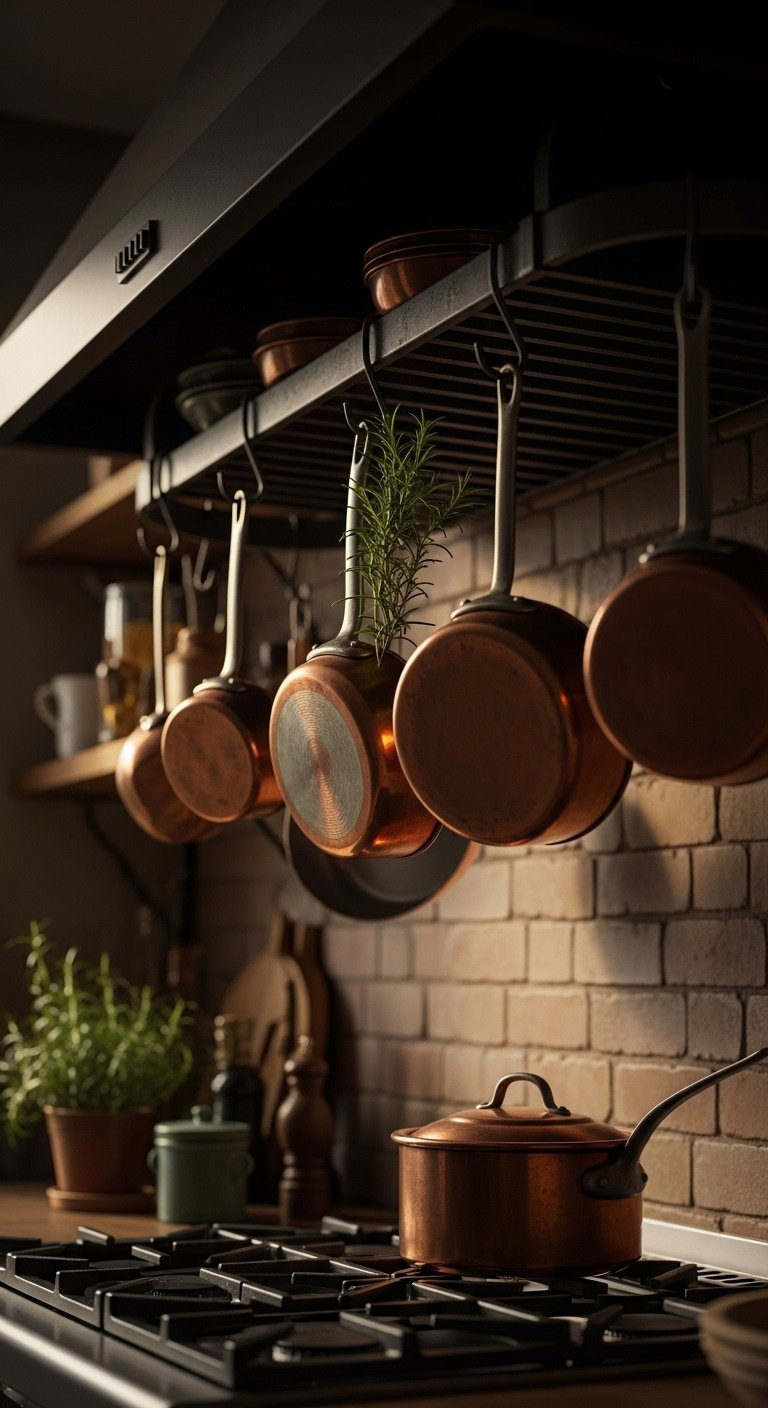
Share this post with a friend who loves vintage finds!
5. Upgrade Cabinetry with Paint & Hardware
For a high-impact, budget-friendly update, transform your existing cabinets with a fresh coat of paint and new hardware. Popular cottage styles include Shaker-style cabinets or beadboard panels, while hardware like unlacquered brass or bin-style pulls can significantly enhance the rustic charm.
You do not need to rip out your entire kitchen to get a new look. If your cabinet layout works for you, a cosmetic refresh can feel like a complete renovation. The combination of a soft new color and character-filled hardware is a powerful duo that can instantly shift your kitchen’s aesthetic from generic to charmingly custom.
Materials Needed:
* Screwdriver
* Degreaser/cleaner
* New cabinet knobs or pulls
* A drilling template (if changing hardware size or style)
Step-by-Step Directions (Hardware Swap):
1. Choose your new hardware. For a classic European cottage look, consider materials with a living finish like unlacquered brass, or timeless options like oil-rubbed bronze, cast iron, or simple porcelain knobs.
2. Use a screwdriver to remove one of your existing knobs or pulls. Take it with you when you go shopping to ensure the screw hole spacing matches, which makes the job much easier.
3. Once you have your new hardware, take a few minutes to unscrew all the old pieces from your drawers and doors.
4. This is the perfect opportunity for a deep clean! Thoroughly wipe down the cabinet fronts with a good degreaser, paying special attention to the area that was hidden under the old hardware.
5. Install your beautiful new hardware. If you’re switching from knobs to pulls, an inexpensive drilling template is a lifesaver to ensure your new holes are perfectly level and evenly spaced.
Lesson Learned: Swapping hardware is, without a doubt, one of the easiest and most impactful budget updates you can make. I was shocked by the difference it made in my own kitchen. It can single-handedly change the entire feel of your cabinetry in under an hour, making it the perfect weekend project.
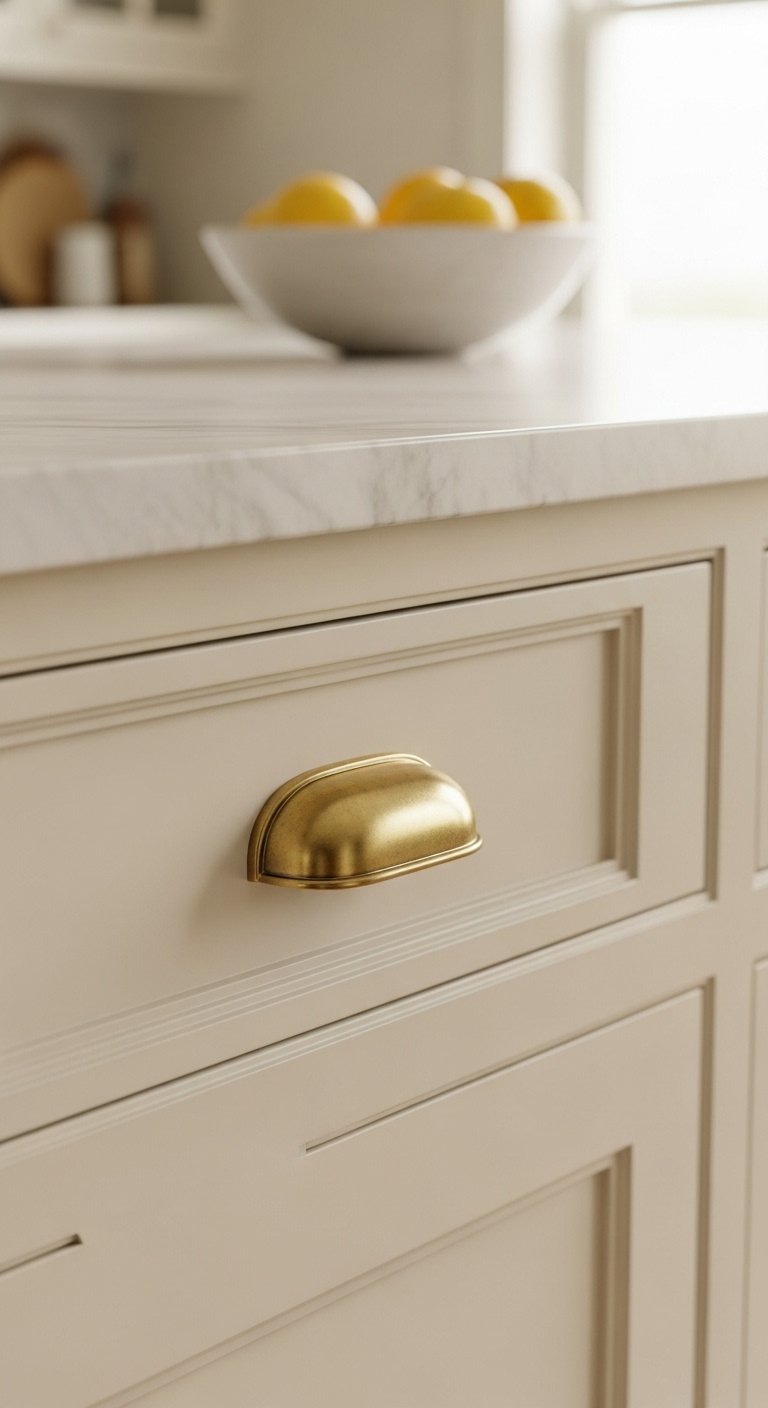
Pin this hardware idea for your next weekend project!
6. Choose Functional and Aesthetic Lighting
Creating a cozy ambiance requires thoughtful lighting choices, blending functional task lighting with charming aesthetic fixtures. Pendant lights, especially those with a vintage or schoolhouse design, add both charm and focused light over islands or sinks, while industrial elements can add an eclectic touch.
Lighting is the jewelry of a room. It can make a space feel warm and inviting or cold and sterile. In a cottage kitchen, a layered approach is best. You need bright, functional light for chopping and cooking, but you also want a soft, ambient glow that encourages guests to linger and makes the room feel cozy in the evening.
Materials Needed:
* New pendant light fixture
* Ladder
* Wire strippers
* Voltage tester
* Wire nuts
* Screwdriver
* (Disclaimer: Always turn off power at the breaker before working on wiring. If you are not 100% confident, please consult a licensed electrician.)
Step-by-Step Directions:
1. Safety first! Go to your home’s circuit breaker and turn off the power to the existing light fixture.
2. Carefully remove the old light fixture. As you disconnect the wires, take a photo or make a note of how they are connected (typically black wire to black, white to white, and the bare copper/green wire to the ground screw).
3. Install the mounting bracket for your new fixture to the electrical box in the ceiling, following the manufacturer’s instructions.
4. Connect the wires of the new fixture to the house wiring using wire nuts, matching the colors as you noted earlier.
5. Secure the new fixture’s canopy to the mounting bracket and install the appropriate light bulbs.
6. Turn the power back on at the breaker and flip the switch to test your beautiful new light.
Pro-Tip: My number one piece of advice for kitchen lighting is to install a dimmer switch for your main overhead lights. It’s a small, inexpensive change that offers incredible control over the mood of the room. It allows you to have bright, functional light when you’re cooking and a soft, warm glow for relaxing evenings or a quiet cup of coffee in the morning.

Light up your kitchen! Save this cozy lighting idea.
7. Add a Classic Farmhouse Sink
An iconic addition to any cottage kitchen is a classic farmhouse sink, which serves as a beautiful focal point and enhances the rustic, lived-in feel. Also known as an apron-front sink, its deep basin is both practical and visually striking, anchoring the design of the room.
There are few kitchen elements as emblematic of the cottage style as a farmhouse sink. Its sturdy presence and exposed front panel evoke a sense of history and hard-working charm. Whether you choose a crisp fireclay model or a vintage cast iron piece, it’s a statement-maker that is as practical for washing large pots as it is beautiful to look at.
Materials Needed:
* Farmhouse sink
* Faucet and drain assembly
* Silicone sealant
* Tape measure
* Jigsaw (for modifying countertop)
* 2×4 lumber for building supports
* (Note: This is an advanced DIY project that requires cabinet and countertop modifications.)
Step-by-Step Directions (Conceptual):
1. Assess Your Space: A true farmhouse sink is an undermount sink that requires a specific base cabinet without a top faux drawer. You’ll need to measure carefully to see if your existing cabinet can be modified or if a new one is required.
2. Build a Support Frame: These sinks are incredibly heavy. You must build a sturdy support frame inside the base cabinet using 2×4 lumber for the sink to rest on securely.
3. Cut Your Cabinet & Countertop: This is the most critical step. You’ll need to carefully measure and cut the front of the cabinet to accommodate the sink’s apron front. The countertop will also need to be cut precisely for the sink basin.
4. Install the Sink: Lower the sink into place on its support frame. It’s best to install the faucet and drain assembly at this stage before finally sealing the gap between the sink and the countertop with a bead of silicone.
Pro-Tip: While a brand-new fireclay sink can be a significant investment, don’t give up on the dream if it’s not in the budget. From my experience haunting salvage yards, you can sometimes find authentic vintage cast iron sinks for a fraction of the price. They may require some elbow grease to have them professionally reglazed, but the unparalleled character they offer is worth the effort.
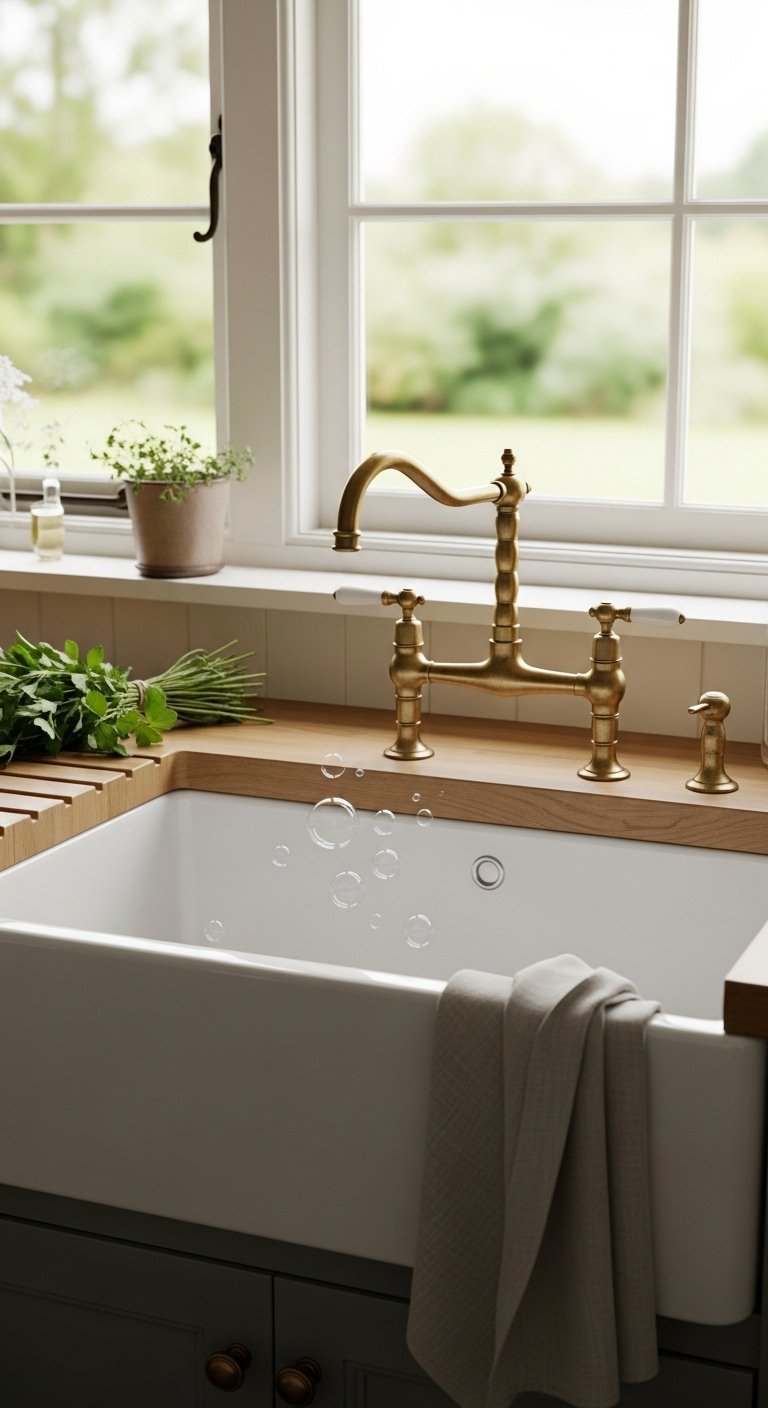
Is a farmhouse sink on your kitchen wishlist? Save this image!
8. Layer in Cozy Textiles and Linens
To complete the cottage look, you need to add soft textiles like gingham or floral curtains, knitted dishcloths, and cushioned seat pads to add comfort and a handcrafted touch. These layers of fabric soften the hard surfaces of a kitchen and introduce valuable color and pattern.
Textiles are the final, cozy layer that makes a kitchen feel like a home. They absorb sound, add softness, and provide one of the easiest ways to inject personality into the space. A simple curtain can frame a window, a cushioned pad can make a nook more inviting, and a stack of pretty linen towels can elevate the simple act of drying dishes.
Materials Needed:
* Fabric of your choice (e.g., linen or a cotton floral print)
* Spring-loaded tension rod
* Measuring tape
* Scissors
* Iron-on hemming tape
* An iron
Step-by-Step Directions (Easy No-Sew Café Curtain):
1. Measure the width of the inside of your window frame and the desired height for your curtain (typically covering the lower half of the window).
2. Cut your fabric so the width is about 1.5 times your window’s width (this allows for a nice, gentle gather) and the height is your desired height plus about 3 inches (for the hems).
3. To create the rod pocket, fold over the top edge by 2 inches. Use your iron and the iron-on hemming tape to press and secure it, leaving the ends open.
4. To create a clean bottom edge, fold over the bottom of the fabric by 1 inch and use the hemming tape to secure it.
5. Slide the tension rod through the pocket you created at the top, and then simply install it inside your window frame. It’s an instant touch of charm!
Pro-Tip: Don’t forget the floor! A vintage-style runner or a durable woven rug is a game-changer in a kitchen. In my own space, adding a runner not only provided welcome comfort underfoot but also gave me a fantastic opportunity to introduce a beautiful pattern and color that anchored the entire design.
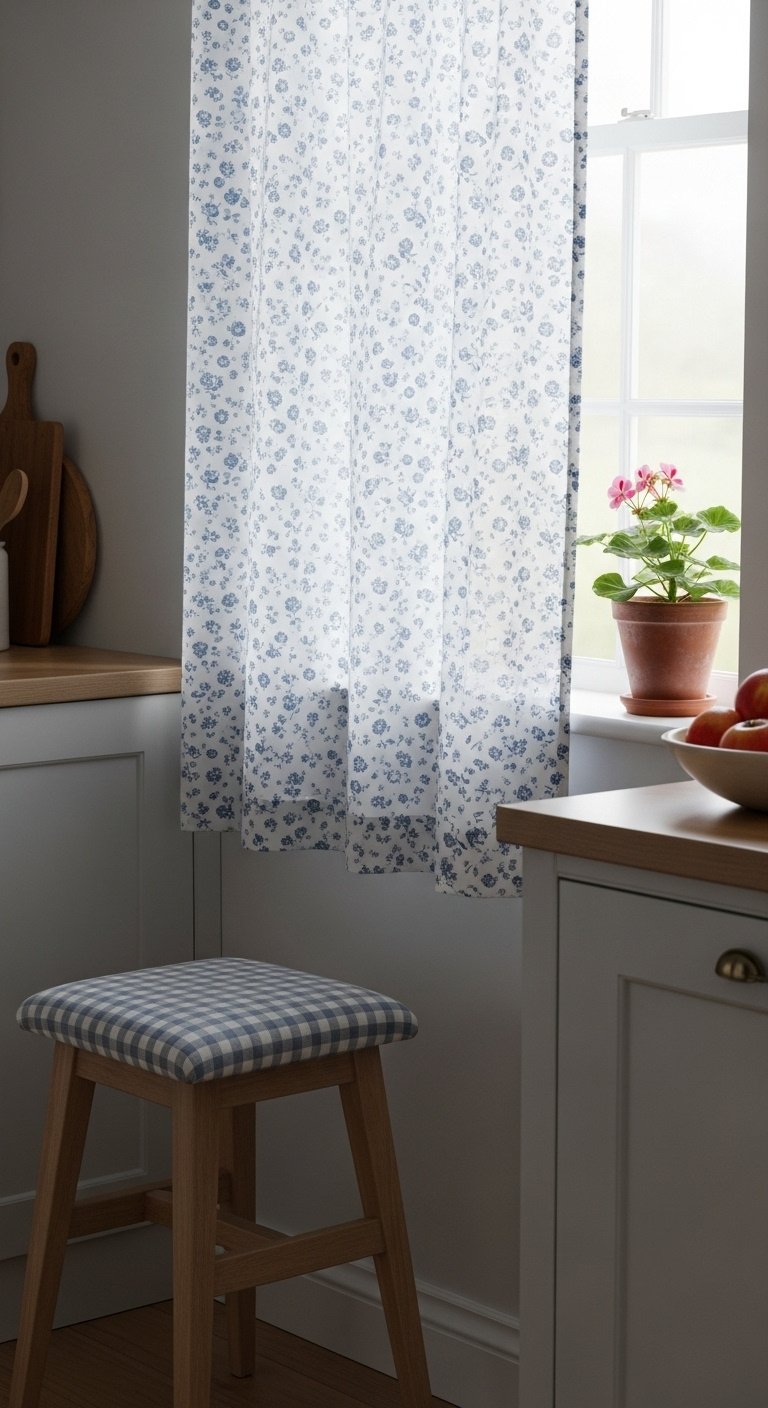
Get this cozy look! Save this idea for later.
9. Add Architectural Details
For kitchens lacking inherent character, you can add architectural elements like plaster finishes, shiplap, beadboard, or exposed beams to create depth and a sense of history. These details provide texture and a custom feel that is crucial to the cottage aesthetic.
Many modern homes are essentially blank canvases, which is great, but they can lack the built-in charm of an older house. The solution is to add that charm back in! Architectural finishes like beadboard or shiplap are a relatively inexpensive way to add texture and a historical feel to an otherwise plain wall or backsplash.
Materials Needed:
* Beadboard panels
* Construction adhesive
* Finishing nails
* Nail gun or hammer and nail set
* Level
* Tape measure
* Jigsaw for cutting outlets
* Caulk
* Paint
Step-by-Step Directions (DIY Beadboard Backsplash):
1. Measure the height and width of your backsplash area. Cut your beadboard panels to size using a circular saw or jigsaw. Remember to carefully measure and cut out holes for any outlets or switches.
2. Apply a quality construction adhesive to the back of the first panel in a zig-zag pattern.
3. Press the panel firmly against the wall, using a level to ensure it’s perfectly straight.
4. Secure the panel by driving finishing nails along the top and bottom edges, and into wall studs where possible.
5. Repeat the process with the remaining panels, making sure the tongue-and-groove edges line up snugly.
6. Fill any nail holes and caulk all the seams and edges for a professional, seamless look.
7. Once the caulk is dry, paint the beadboard with a durable, semi-gloss paint in your chosen cottage color.
Lesson Learned: In my experience working on newer homes, adding details like beadboard is the single fastest way to cheat architectural history. It instantly creates a sense of character and craftsmanship that is absolutely essential to the authentic cottage aesthetic, making a new space feel like it has been there for decades.
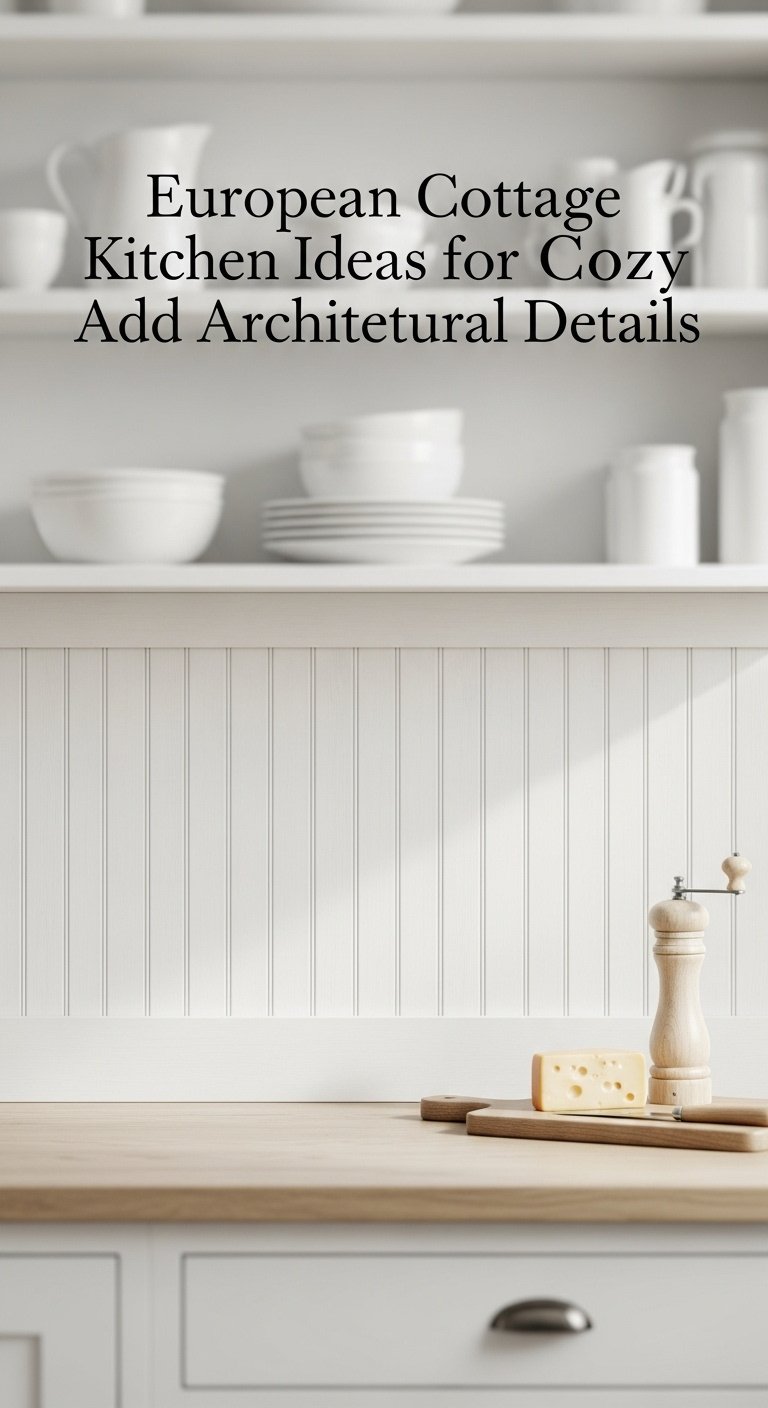
Add instant character! Pin this backsplash idea.
Key Takeaways: Your Quick Guide to a European Cottage Kitchen
Feeling inspired? Here is a quick, scannable summary of the core principles to remember as you begin your kitchen transformation journey.
- Prioritize a Soft Palette: Start with a foundation of whites, creams, and muted pastels to create the light and airy base essential for the cottage feel.
- Incorporate Natural Materials: Warm woods and natural stone are non-negotiable. They provide the authentic rustic charm that defines the style.
- Embrace Imperfection: The beauty is in the mix. Layer in vintage finds, handmade items, and mismatched dishes to create a collected, lived-in atmosphere.
- Focus on Texture: Add character and depth with tactile elements like beadboard, cozy textiles, and woven baskets.
- Start Small for Big Impact: Remember, you don’t need a full renovation. Begin with high-impact, budget-friendly updates like new cabinet hardware, a different light fixture, or charming textiles.
People Also Ask About European Cottage Kitchens
Have more questions? You’re not alone. Here are direct answers to some of the most common queries about achieving the European cottage kitchen style.
What style is European cottage?
European cottage is a design style focused on creating a cozy, charming, and whimsical atmosphere. It emphasizes natural materials like stone and timber, soft, muted color palettes, vintage or antique furniture, and a lived-in, collected feel. It leans more romantic and quaint compared to the more utilitarian American farmhouse style.
What is the difference between an American kitchen and a European kitchen?
Generally, European kitchens, particularly modern ones, feature frameless cabinets for a sleek, open look, while American kitchens traditionally use framed cabinets, which can appear busier. In terms of cottage styles, the European version often incorporates more plaster, stone, and romantic details, while the American farmhouse style might feature more shiplap and practical, rustic elements.
What are the key elements of a European cottage kitchen?
The key elements include a soft, muted color palette (whites, creams, pastels), warm wood tones (butcher block, beams), open shelving for displaying dishware, vintage or handmade decor, charming hardware like brass bin pulls, a classic farmhouse sink, and cozy textiles like linen and floral prints.
How can I make my kitchen look more cottage-style on a budget?
You can make your kitchen more cottage-style on a budget by starting with paint—a soft, creamy white can transform the space. Swap out modern cabinet hardware for vintage-style brass or porcelain knobs. Remove a few upper cabinet doors for an open-shelving look. Finally, add cozy textiles like a café curtain, a woven rug, and linen dish towels.
Final Thoughts
Creating a European cottage kitchen is less about a massive overhaul and more about the art of layering character, warmth, and your own story over time. It’s a wonderfully forgiving style that celebrates the beauty of imperfection and the history behind each treasured piece. You don’t need a huge budget or a grand plan to get started.
My best advice is to simply begin. Pick one or two ideas from this list that truly excite you and enjoy the process of slowly building a kitchen that feels uniquely, comfortably, and beautifully you.
Which cozy idea will you try first? I’d love to hear about it in the comments below
